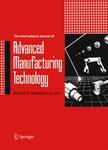版权所有:内蒙古大学图书馆 技术提供:维普资讯• 智图
内蒙古自治区呼和浩特市赛罕区大学西街235号 邮编: 010021

作者机构:Calif State Univ Sacramento Dept Mech Engn Sacramento CA 95819 USA Mori Seiki Mfg Inc Davis CA USA Nanyang Technol Univ Sch Mech & Aerosp Engn Singapore 639798 Singapore
出 版 物:《INTERNATIONAL JOURNAL OF ADVANCED MANUFACTURING TECHNOLOGY》 (国际先进制造技术杂志)
年 卷 期:2013年第64卷第5-8期
页 面:1169-1175页
核心收录:
学科分类:12[管理学] 1201[管理学-管理科学与工程(可授管理学、工学学位)] 08[工学] 0802[工学-机械工程] 0811[工学-控制科学与工程]
基 金:California State Research and Creative Activity Award
主 题:Sequential forward search Neuro-fuzzy systems
摘 要:Tapping has been widely used throughout industry, and its proper operation is paramount in ensuring product quality. Therefore, monitoring and diagnosis are needed to detect the tapping process conditions. They are also important for automated manufacturing. In this work, a combination of ten indices of the tapping process was extracted from tapping torque, thrust force, and lateral forces. The Sequential Forward Search (SFS) algorithm has been used to select the best feature sets. Adaptive Neuro-Fuzzy Inference Systems (ANFIS) were used for the monitoring and diagnosis of tapping process. A 3 x 2 ANFIS structure can distinguish normal tapping process from abnormal tapping process with 100 % reliability. The tapping process conditions can be further classified into five categories with over 95 % success rate using a 10 x 2 ANFIS structure for diagnostic purpose. In simple words, monitoring and diagnosis of tapping process can be carried out successfully using SFS and ANFIS.